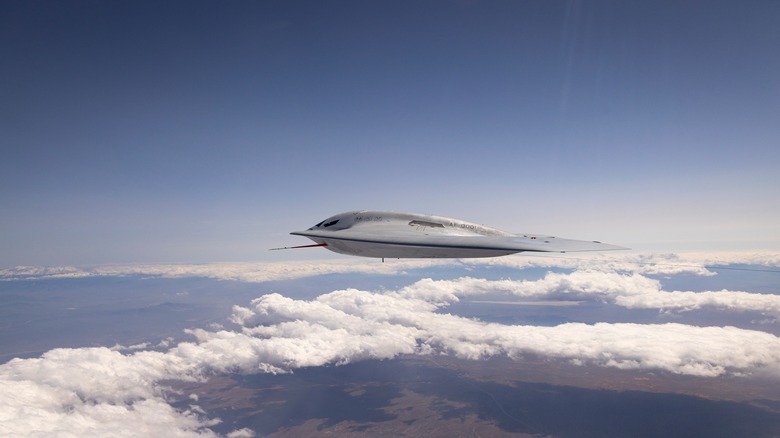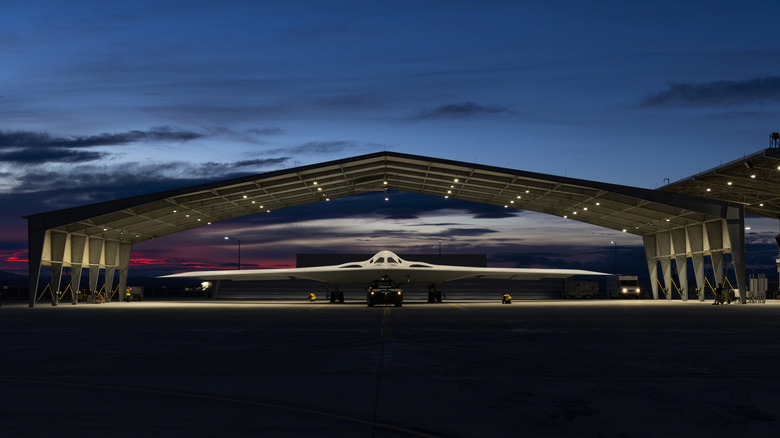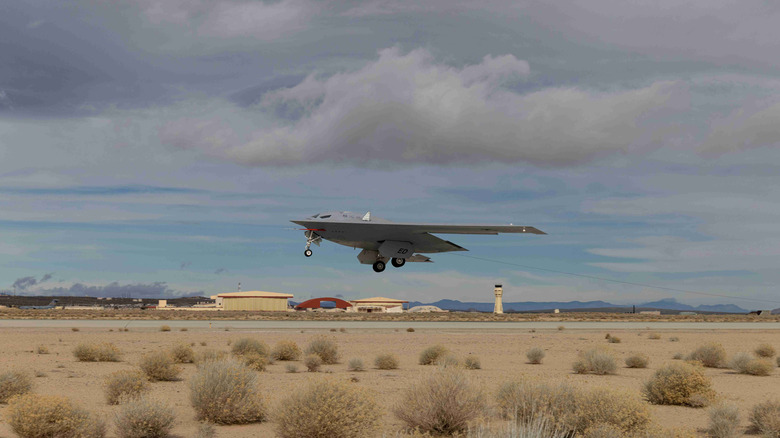Why The New B-21 Raider's Twin Engines Are Still A Mystery
The B-21 Raider isn't only the next-generation stealth bomber replacing the B-2 Spirit, it's also the first sixth-generation aircraft. The B-21 is sure to change the landscape of air power. As you can imagine, it's been shrouded in secrecy since the U.S. Air Force made its development public in 2015. Bits and pieces slowly rolled out over the years, giving the public a rough idea of its design. Some theories were confirmed when Northrop Grumman and the Air Force unveiled the new bomber in December 2022, such as its look and size, which are relatively close to its predecessor's. However, Northrop Grumman and the Air Force are still keeping certain details of the Raider under wraps, especially the specs of its twin engines.
Despite being shown off at Northrop Grumman's plant in Palmdale, California, journalists present didn't get the best look at the new stealth bomber. Officials only wheeled it halfway out of its hangar, preventing everyone from getting a full look at its design, but the event also took place at night. To top it off, those present were only allowed to see the bomber from the front. Few questions were answered about the aircraft's specifications. Even basic information about its engines was not made available.
Not much more was learned about the B-21's engines even after its first engine run on September 2023. Experts suspect it's using powerplants descended from Pratt & Whitney's F135, the same engine used by the controversial F-35 program, but nothing has been confirmed.
Why all the secrecy?
The B-21 Raider is the first new bomber for the United States Air Force since 1989, ushering in the sixth generation of aircraft. When it comes to advanced technology, America likes to keep some details close to its chest. Even today, the United States won't sell the F-22 Raptor to foreign countries as a precaution. It's one of the most advanced fighter jets in the world, and if it were to fall into the wrong hands, it would put America at a disadvantage. It's no different with the tight lips when it comes to the B-21 engines.
If adversaries knew intimate details about developing technology, they'd be able to add similar tech to their aircraft or upgrade defensive systems to counter the bomber. Air Force Gen. Arnold Bunch Jr. told the Senate Armed Services Committee in 2016, "We're trying to balance the transparency that we want to do with the public so that they understand what we're doing, but we're also trying to protect the critical capabilities of this asset."
When it comes to designing stealth aircraft, there are a lot of different tradeoffs that engineers make in order to reduce its radar signature. Keeping these details hush-hush is as much about the actual stealth technology as it is about the various choices and mixes made. One type of engine might provide superior thrust, but it also might mean increased visibility on infrared systems.
What flight tests reveal
In November 2023, Northrop Grumman and the Air Force moved along to the flight test phase of the B-21 Raider's production, following ground and engine tests. While this has yielded data, it hasn't been given to the general public. Even the shared images continue to be from angles that obstruct a good view of the plane's rear, which would give everyone a better idea of its engines.
The Air Force Test Center at Edwards Air Force Base in California is carrying out flight tests. These flight tests gauge the B-21's capabilities, including penetrating strikes as well as deterring attacks against the U.S. and its allies.
While there's only one B-21 currently at Edwards, another five pre-production models are expected to join it in the near future before Ellsworth Air Force Base in South Dakota receives the first operational Raider squadron. However, it's very likely that specific details about the B-21's systems, including its cutting-edge engine, won't be released until it has been flying for some time.


